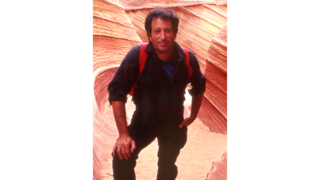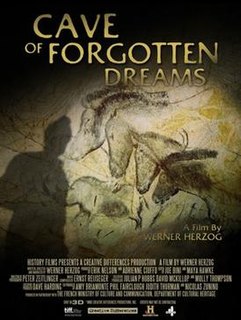Related Research Articles

Werner Herzog is a German film director, screenwriter, writer, actor, and opera director. Herzog is considered a figure of the New German Cinema. His films often feature ambitious protagonists with impossible dreams, people with unique talents in obscure fields, or individuals who are in conflict with nature.

The Enigma of Kaspar Hauser is a 1974 West German drama film written and directed by Werner Herzog and starring Bruno Schleinstein and Walter Ladengast. The film closely follows the real story of foundling Kaspar Hauser, using the text of actual letters found with Hauser.
Xerox art is an art form that began in the 1960s. Prints are created by putting objects on the glass, or platen, of a copying machine and by pressing "start" to produce an image. If the object is not flat, or the cover does not totally cover the object, or the object is moved, the resulting image is distorted in some way. The curvature of the object, the amount of light that reaches the image surface, and the distance of the cover from the glass, all affect the final image. Often, with proper manipulation, rather ghostly images can be made. Basic techniques include: Direct Imaging, the copying of items placed on the platen ; Still Life Collage, a variation of direct imaging with items placed on the platen in a collage format focused on what is in the foreground/background; Overprinting, the technique of constructing layers of information, one over the previous, by printing onto the same sheet of paper more than once; Copy Overlay, a technique of working with or interfering in the color separation mechanism of a color copier; Colorizing, vary color density and hue by adjusting the exposure and color balance controls; Degeneration is a copy of a copy degrading the image as successive copies are made; Copy Motion, the creation of effects by moving an item or image on the platen during the scanning process. Each machine also creates different effects.

The British Film Institute (BFI) is a film and television charitable organisation which promotes and preserves filmmaking and television in the United Kingdom. The BFI uses lottery funds to encourage film production, distribution, and education. It is sponsored by the Department for Digital, Culture, Media and Sport.

A virtual museum is a digital entity that draws on the characteristics of a museum, in order to complement, enhance, or augment the museum experience through personalization, interactivity and richness of content. Virtual museums can perform as the digital footprint of a physical museum, or can act independently, while maintaining the authoritative status as bestowed by the International Council of Museums (ICOM) in its definition of a museum. In tandem with the ICOM mission of a physical museum, the virtual museum is also committed to public access; to both the knowledge systems imbedded in the collections and the systematic, and coherent organization of their display, as well as to their long-term preservation.
The Australian Centre for the Moving Image (ACMI), at Federation Square, Melbourne, is Australia's national museum of film, video games, digital culture and art. During the 2015–16 financial year, 1.45 million people visited ACMI, the second-highest attendance of any gallery or museum in Australia, and the most visited moving image museum in the world. In May 2019, ACMI closed to the public to begin a $40 million redevelopment.

David Edward Gatten is an American experimental filmmaker and moving image artist. Since 1996 Gatten's films have explored the intersection of the printed word and moving image, cataloging the variety of ways in which texts functions in cinema as both language and image, often blurring the boundary between these categories. His 16mm films often employee cameraless techniques, combined with close-up cinematography and optical printing processes. In addition to the ongoing 16mm films, Gatten is now making hybrid 16mm/digital works and has completed an entirely digital feature-length project called The Extravagant Shadows.
Judy Fiskin is an American artist working in photography and video, and a member of the art school faculty at California Institute of the Arts. Her videos have been screened in the Documentary Fortnight series at the Museum of Modern Art in New York, at the Los Angeles County Museum of Art, the Hammer Museum in Los Angeles, and at the J. Paul Getty Museum in Los Angeles; her photographs have been shown at MOCA, the Museum of Contemporary Art in Los Angeles, at the Getty Museum in Los Angeles, at The New Museum in New York City, and at the Pompidou Center in Paris.

Henning Lohner is a German-American composer and filmmaker. He is best known for his film scores written as a long-standing member of Hans Zimmer’s music cooperative Remote Control Productions.
Adam Chodzko is a contemporary British artist, exhibiting internationally. His practice uses a wide range of media, including video, installation, photography, drawing, and performance.

Peter Guttman is an American author, photographer, lecturer, television personality and adventurer who has traveled on assignment through over 230 countries and seven continents.

D. Dominick Lombardi is a visual artist, writer and art critic; the U.S. editor of dArt international magazine; as well as a curator. He was an art critic for The New York Times from 1998 to 2005.

The Addison Gallery of American Art, as a department of Phillips Academy in Andover, Massachusetts, is an academic museum dedicated to collecting American art. The museum's purpose is to acquire, preserve, interpret, and exhibit works of art for the education and enjoyment of local, regional, national and international audiences, including the students, faculty, and community of Phillips Academy, and other students, teachers, scholars and the general public.
Berwick Film & Media Arts Festival (BFMAF) is an annual festival with a focus on new cinema and artists' moving image. The festival programme takes place across Berwick-upon-Tweed and includes exhibitions, film screenings, live events, school screenings and family activities.

Cave of Forgotten Dreams is a 2010 3D documentary film by Werner Herzog about the Chauvet Cave in southern France, which contains some of the oldest human-painted images yet discovered. Some of them were crafted around 32,000 years ago. The film premiered at the 2010 Toronto International Film Festival and consists of images from inside the cave as well as of interviews with various scientists and historians. The film also includes footage of the nearby Pont d'Arc natural bridge.
Joshua Mosley is an American artist and animator. He is Professor and Chair of Fine Arts in the School of Design at the University of Pennsylvania. His work is represented by Corbett vs Dempsey in Chicago. He is the recipient of the 2007 Joseph H. Hazen Rome Prize in Visual Arts and the 2005 Pew Fellowship in the Arts.

Mike Stubbs is a curator/director and filmmaker based in the UK, currently, the Creative Producer at Doncaster Creates. For 11 years he was the Director/CEO of FACT, the Foundation for Art and Creative Technology, a leading arts organisation for the commissioning and presentation of new media art forms. He has been a key contributor to the development of culture and cultural policy in Liverpool, UK. Stubbs was jointly appointed in May 2007 by Liverpool John Moores University, where he is Professor of Art, Media and Curating.
Directors Lounge is an ongoing Berlin-based film and media-art platform with year-round screenings and exhibitions in Berlin and various other cities. Annually parallel to the Berlin Film Festival (February), the central event of the Directors Lounge, the intensified presentation The Berlin International Directors Lounge takes place. Directors Lounge is the brainchild of filmmaker André Werner, artist Joachim Seinfeld and gallerist/curator Longest F. Stein in conjunction with the A&O-gallery and other artists from the Berlin media art scene.
Single-channel video is a video art work using a single electronic source, presented and exhibited from one playback device. Electronic sources can be any format of video tape, DVDs or computer-generated moving images utilizing the applicable playback device and exhibited using a television monitor, projection or other screen-based device. Historically, video art was limited to unedited video tape footage displayed on a television monitor in a gallery and was conceptually contrasted with both broadcast television and film projections in theatres. As technology advanced, the ability to edit and display video art provided more variations and multi-channel video works became possible as did multi-channel and multi-layered video installations. However, single-channel video works continue to be produced for a variety of aesthetic and conceptual reasons and the term usually now refers to a single image on a monitor or projection, regardless of image source or production.
The BFI Gallery was the BFI's contemporary art gallery dedicated to artists' moving image housed within BFI Southbank, the British Film Institute's flagship venue in London. The space was funded by the BFI with Arts Council England support and opened on 14th March 2007, to coincide with the reopening of the site. Its programme of new commissions, events and associated artists' film screenings was curated by Elisabetta Fabrizi, BFI Head of Exhibitions. The programme included exhibitions by Michael Snow, John Akomfrah, Apichatpong Weerasethakul, Pierre Bismuth, Jane & Louise Wilson, Peter Campus, Patrick Keiller, Phil Collins, Matt Collishaw, Yvonne Rainer, Julian Rosensfeld, Michel Gondry, Deimantas Narkevicious, Mark Lewis. Film programmes linked to the gallery exhibitions included a retrospective of the films of Sergei Paradjanov and of Michael Snow.
References
- ↑ Greencine "Archived copy". Archived from the original on 2008-06-11. Retrieved 2008-07-02.CS1 maint: archived copy as title (link)
- ↑ From http://www.movingimagesource.us/articles
- ↑ From http://www.movingimagesource.us/events
- ↑ From http://www.movingimagesource.us/events/venues
- ↑ From http://www.movingimagesource.us/research